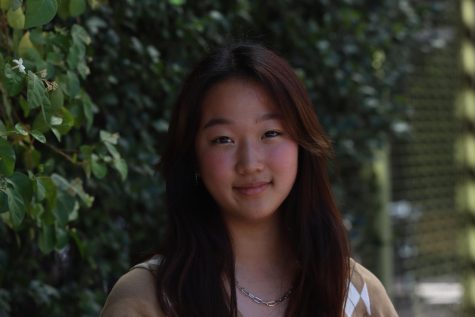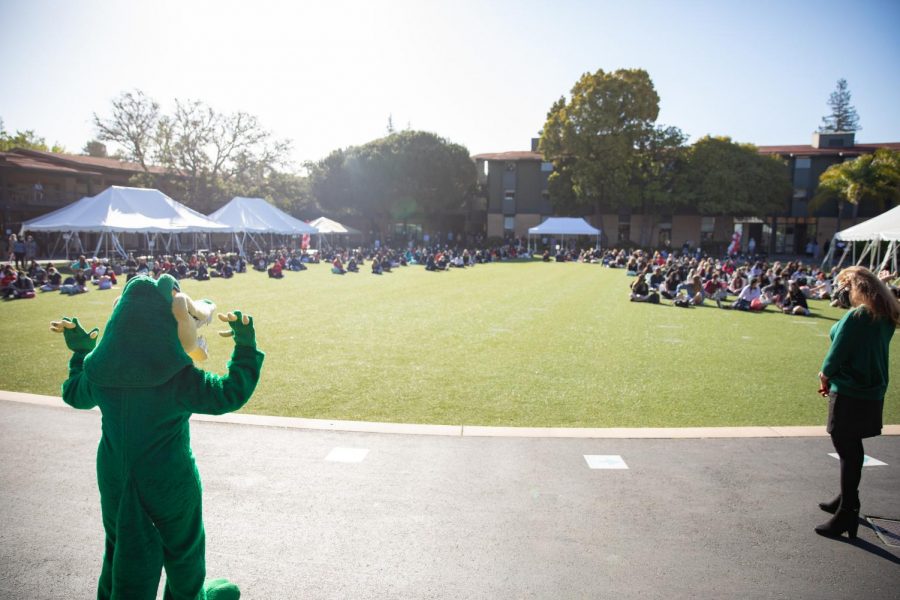Back to normal: Miracle or mirage?
On May 3, 2021, Castilleja welcomed back all 7 grades to campus for the final weeks of school
“It’s going to disappear. One day — it’s like a miracle — it will disappear” were the infamous words of Donald Trump, former US President, regarding the coronavirus. I personally recall him stating this mantra repeatedly, and like everyone else in the world, I’m still waiting for that miracle to magically happen. In all fairness, Trump’s words were somewhat reassuring if his intent was to minimize anxiety. I don’t think anyone, even Donald Trump, could have predicted back in March 2020 how weird this pandemic would be and for how long it would grip our society. Sitting here now in May 2021, the miracle feels like it is slowly but surely starting to take hold, at least in Santa Clara County with decreasing case rates and increasing vaccine availability.
For me, the marker for returning to “normalcy” was May 3, the start of in-person school for all grades at Castilleja. Six months ago, I would have been doing the macarena in my pajamas at the prospect of it all. However, now with the school year almost over, it seems that many of us are feeling more mixed about our return to in-person school. According to a Google form survey sent out to the Castilleja student body after our first week back, the same number of students ranked hybrid as their preferred school option as in-person full time. When asked about the effects of in-person school on their learning, Castilleja students seem to share three recurring challenges: energy levels, logistical concerns, and hybrid convenience.
Despite incessant whining that all-day Zoom is physically exhausting, it seems that many students have realized in-person school is actually more fatiguing, after all. Apparently, being back on campus in the same physical space with actual people seems to be taking a toll on the mental and social stamina of many students.
“I originally thought that in-person would be better, as it was the norm until a year ago, but I’ve found that it is much more exhausting than hybrid or online,” one student submitted. Fatigue goes hand in hand with difficulty concentrating, and many students have found in-person classes to be just as distracting as being online. Another student stated, “I’m more exhausted by the end of the day, making it hard to concentrate in all my classes. It’s just very overwhelming to have so many stimuli around me again.”
These stimuli include processing and complying with complicated logistics in order to be around other germ-carrying humans. With cohorts, social distancing, and assigned locations on campus, one student remarks how “it’s much more crowded and feels more overwhelming with everyone on campus.” Having the whole student body on campus has simply increased the number of bodies present, and in turn, has forced more distancing rules into place. “I’ve had to spend break on Spieker field which isn’t fun and it’s been weird trying to figure out cohorts… it’s really confusing,” another student reflects.
Though in-person classes were how the Castilleja school day has been conducted for the last 100 or so years, this school year has afforded new, uncharted experiences with different learning approaches. One upside has been the realization that hybrid learning has some attractive benefits. “I liked the one week off, one week on style because it really helped balance the tiredness of in-person school and the awkwardness of online,” one student wrote. Distance learning offers sleeping in and shorter commute times, but in-person eliminates distractions and increases cross-grade bonding. Hybrid, however, balances the pros of both in-person and distance learning, allowing everyone’s needs to be satisfied.
What about the students who chose to stay remote though? On the Google form, students marked the top two reasons for preferring to stay home as 1) safety concerns and 2) commute time.
Zoe Ho ‘23 is one of the remote students who chose to stay home due to safety concerns. “With this big change, I thought that it would just be safer to stay back home and see how the situation plays out,” Ho remarks. With plans to travel to a foreign country in the summer, Ho decided to wait until her vaccination and remain home to limit her risk of exposure before the trip.
Alexis Eskenazi ‘23 also chose to stay remote, though her reason was due to commute time and convenience. As someone who lives further away from campus, Eskenazi decided that returning back to school would be more logistically challenging for her family and instead chose to utilize the benefits that at-home learning provides. “I don’t feel like my learning has really been compromised at home,” Eskenazi said. “I didn’t feel like it was a necessity for me to be back in person in order for me to make the most of my educational experience.”
Conversely, another remote student wrote that “it is sometimes difficult being online when everyone else is in person. In a lot of cases, teachers are focused on the majority of the class, which is in person. As a result, I sometimes feel ignored, because the teachers can’t see me.” At the end of the day, everyone is constantly doing their best to adapt to the new changes and situations presented. Regardless of all the challenges, Eskenazi reflects how “Casti and my teachers have done such a great job getting me whatever I need online and just being available, and I really appreciate that.”
All in all, being back on campus with everybody has felt somewhat surreal. Despite those campaigning for hybrid learning, numerous students have remarked that concentration, participation, and motivation feel stronger with in-person learning. With traditions back in place and campus culture back in full throttle, “it gives me hope for returning back to normal life.” While the return to our old normal may not be a chango-presto miracle, a new and different normal feels like it is slowly emerging.

Kelly Yang is one of the Co-Editors-in-Chief of Counterpoint. This is her fourth year as part of the Counterpoint team and her second year as an EIC. When...


